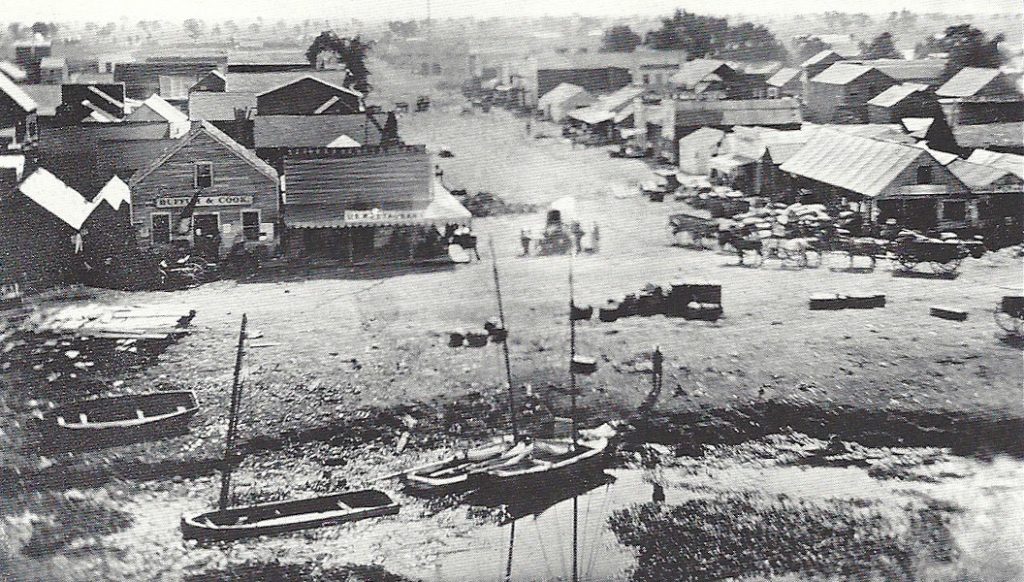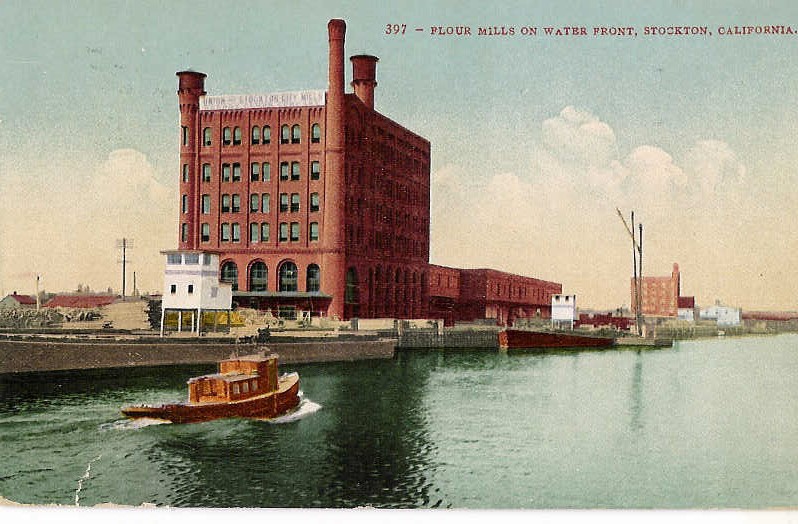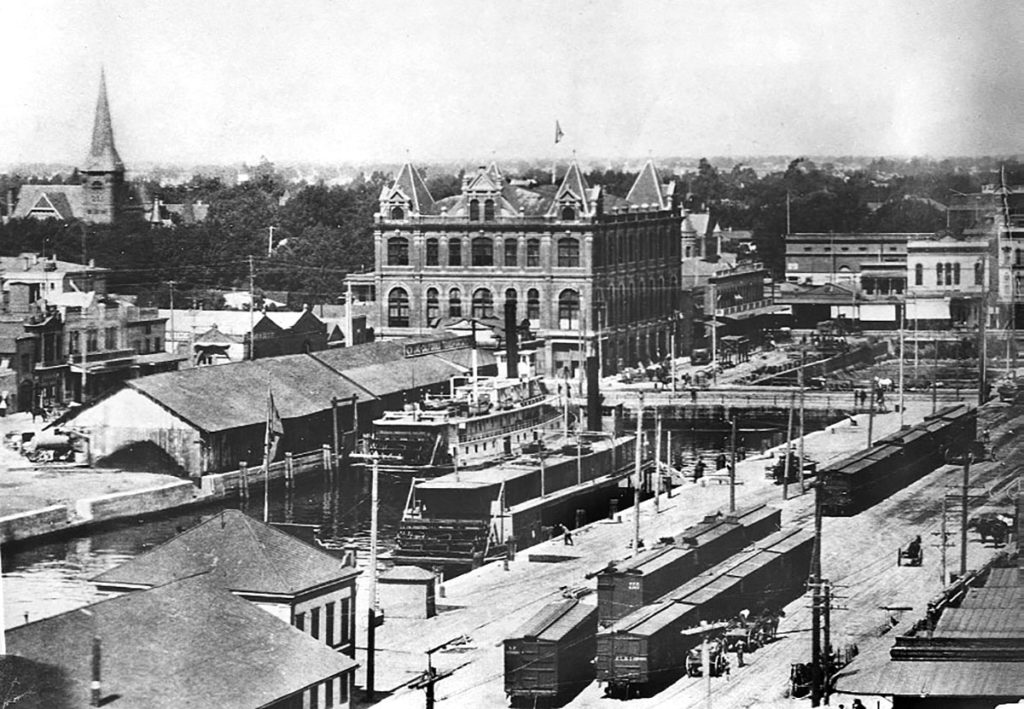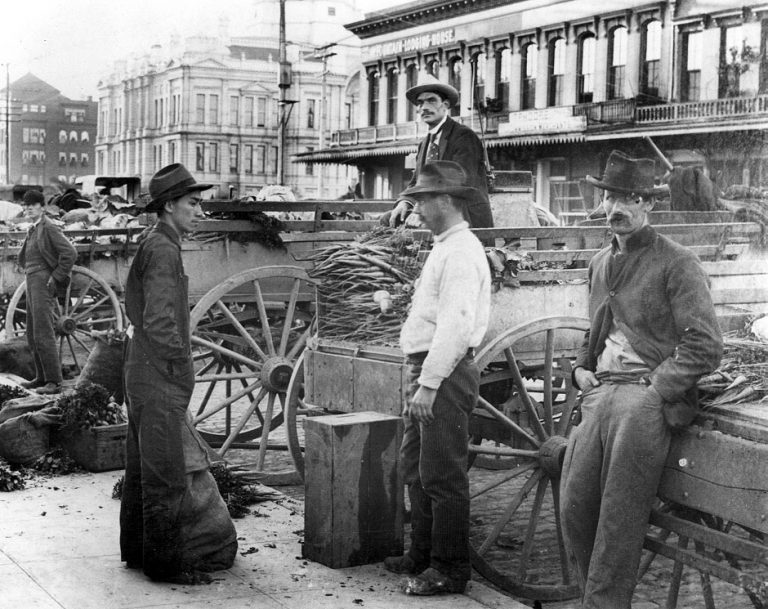
Stockton in the early to mid 1800s.

The Stockton Harbor in the late 1800s. Sperry Flour Mill buildings are visible left in the background.

Stockton circa 1908.
Downtown History
Downtown is the historic heart of Stockton. Founded in 1849 by Captain Charles Maria Weber, and named for Commodore F. Stockton, Stockton began with a mix of thriving commercial ventures and colorful characters. Industrious citizens altered the natural waterways running through the city to alleviate flooding, coordinated interstate water and rail with local transportation systems, and optimized Stockton’s strategic geographic location at the crossroads of California.
Walk With Weber Audio Tour

Want to learn more about Downtown’s history? Take the Walk With Weber self-guided, walking audio tour of some of Downtown’s most prominent historic buildings.
Narrated by DSA’s former historian ambassador, Manuel Laguna, Walk With Weber shares interesting bits of trivia about the origins of downtown. There are 24 stops, each featuring an audio clip and accompanying historical photographs, which are accessible remotely via your computer, but can also be enjoyed on your mobile device as you stroll through Downtown.
Keep an eye out for tour QR codes displayed in the windows of many of the stops! Read more about Walk With Weber in this blog article and in The Record.
Postcards
The following Postcards from the Past are provided by Alice van Ommeren, the author of “Stockton in Vintage Postcards” and a member of the Stockton Cultural Heritage Board.
- The Spirit of Stockton’s
Chinatown - Hunter Square
- Remembering Main Street
- Cunningham Castle
- Stockton’s Famous Mineral Baths
SPIRIT OF STOCKTON’S CHINATOWN
Downtown Stockton was home to a historical Chinatown, due to an influx of Chinese immigrants from Kwangtung province during the 1850’s. The Gold Rush in California and unrest in China made immigration attractive at the time. Once the Gold Rush ended, the railroad and other developments led to additional jobs and settlement in Stockton. Stockton quickly became home to the 3rd largest Californian Chinese community within a few decades.
The original Chinatown was nestled on Channel Street, between El Dorado and Hunter. After a destructive fire swept through the settlement, the community created a new home on the southern bank of Mormon Slough. In later years, the hub of Chinese restaurants, shops, residences, social activities, and gambling rooms relocated to E. Washington Street between Hunter and Center.
Unfortunately, laws discriminating against Chinese immigrants meant that Chinese immigration was restricted and residents were prevented from purchasing property until the late 1800’s. In the early 1900’s, Chinese-Americans born in the United States were finally allowed to purchase property. A 1920-built hotel, The Lincoln Hotel, owned by the Wong brothers and located on S. El Dorado Street, was deemed one of Stockton’s best hotels of the day.
The 1960’s construction of the HWY 4 Crosstown Freeway led to the destruction of most of Stockton’s Chinatown. However, a few gems remain to remind us of its cultural legacy: the Lee Center and Chung Wah Lane- which was recently revitalized by the Downtown Stockton Alliance – are standing on the site of Stockton’s original Chinatown; and the Chinese Benevolent Society building still stands on Lafayette Street.
HUNTER SQUARE
Charles M. Weber donated the land for Hunter Plaza, now known has Hunter Square, to the City of Stockton in the 1850s. He envisioned it to be the heart of the city and modelled it after plazas traditional to Mexican and Spanish townships.
Historically, Hunter Square was at the center of banking, public meetings, local government, rallies, retail, markets, fairs, concerts, and festivals. The Square has seen four courthouses constructed next to it over the last 150 years.
Due to its important status as a central gathering place, Hunter Plaza has hosted many events in Stockton’s history. One particularly distinguished event was the California State Fair of 1857. Another exciting fete, this time a Centennial Celebration, took place on July 4, 1876. Furthermore, the plaza hosted “Rush of ’49” in 1909, which was a street fair centered on a faux gold mining camp.
Traditionally, the plaza featured a fountain. In the 1850s, a lovely artesian fountain was built for the plaza, and won a CA State Fair blue ribbon; however, in later years, the well dried up and the fountain was destroyed. A tall, classical-style drinking fountain – known as the “Mail Fountain” – made of granite and funded by donations to the Stockton Mail newspaper, was built on the Main Street-facing side of the Plaza in 1891. This fountain contained a novel ice-holding chamber which cooled the drinking water.
In 1967, another fountain was built with the intention of being a centerpiece in the newly renovated Hunter Square. With the construction of the newest Courthouse in 2017, this fountain was removed from the Hunter Square location, but the fountain’s metal center was incorporated into the roundabout on Miner and San Joaquin as a part of the Miner Avenue beautification project that finished in the early 2020’s,
REMEMBERING MAIN STREET
Main Street, once a hub of unique retailers, essential services, and at one time, even a trolley, was the bustling center of Downtown Stockton commerce in the City’s early years.
While Stockton businesses were initially set up along the waterfront, which was easily accessible for gold mining traders using the waterways for transportation, by 1851, these waterfront businesses had suffered multiple instances of flooding and fires and slowly began moving their locations to Main Street.
Early Main Street buildings were made of wood and housed grocers, saddle and harness shops, hardware stores, machinery retailers, and more. Originally the roads were unpaved and designed for horse drawn buggies, while the pedestrian sidewalks were made of wood. By the early 1900s, Stockton grew into an advanced, enterprising city. Visitors in streetcars flocked to Main Street, which was packed full of industrious banks, welcoming hotels, and exciting theatres.
In the 1930’s and 40’s, Main Street welcomed multiple skyscrapers and small shops were replaced by huge retailers, like the Owl Drug Store, J.C. Penney’s, Woolworth’s, David A. Levinson’s Women’s Apparel shop, and others.
By the 1960’s, Main Street was converted into a one-way street to streamline traffic flow, and the west side of Main Street became closed off by the fountain placed in Hunter Square Plaza. As shops opened in other areas of Stockton, including the malls on Pacific Avenue, the heyday of Main Street began to fade.
Today, Main Street is poised for revitalization, with one of the most recent projects being the completion of the apartments at 500 E. Main Street.
CUNNINGHAM CASTLE
This 1893 jail – nicknamed “Cunningham’s Castle” and built for $90,000, under direction of Sheriff Thomas Cunningham, to resemble a medieval style castle – was located on the corner of San Joaquin and Channel.
The Richardsonian Romanesque design was a popular style in the 1890’s in large northeastern U.S. cities. The unique building was distinguished by round stone towers, conical-roofed turrets, short columns, and contrasting stone features.
Cunningham’s Castle, which could hold up to 75 prisoners, had some of the most modern features and top-level security for its time; it also used its own gas well to produce both heat and lighting. There were six basement cells, eight cells on the first two floors, as well as cells to hold female prisoners and witnesses.
By the 1940’s, the jail averaged 400+ inmates, clearly surpassing capacity, due to an increase in the population of Stockton. A capacity record was reached in 1954, at which time the building held 518 prisoners. In 1958, there were complaints of inhumane conditions in the jail and so the last prisoner was released in April of that year. In addition to the capacity constraints, the building’s mortar had begun to weaken, so Cunningham Castle was torn down in 1961. The site of the old jail was named a Stockton Historical Landmark by Stockton City Council in 1972. Today, the Catholic Diocese of Stockton stands on the site.
STOCKTON’S FAMOUS MINERAL BATHS
In the 1800s, Stockton was known for its restorative mineral baths, the first of which were the Weber Baths, established in 1883 at the current location of the Hotel Stockton. Stockton’s naturally occurring gas wells pushed up a steady flow of warm mineral water rich in iron, sulphur, magnesium, soda, and salt into the baths, which was considered therapeutic. The Weber Baths contained a large swimming tank and over forty rooms for dressing. Most of the wells dissipated by the 1940s, so the only record left of these recreational sites are drawings and postcards from their heyday.
Source: The source for most of the information on this page is Stockton’s Golden Era: An Illustrated History. by Alice van Ommeren. This book is available for purchase at this link.
Books About Downtown
Two books released from Arcadia Publishing celebrate the faces and places that shaped today’s Stockton. “Downtown Stockton” and “Stockton In Vintage Postcards” Both books are available for $19.99 at area bookstores, Arcadia Publishing or in the offices of the Downtown Stockton Alliance.
Other Historical Resources
Learn more about Downtown Stockton’s interesting past through the links below.

San Joaquin County Historical Society & Museum
City of Stockton – History
Visit Stockton – Stockton History
University of The Pacific Archives
Bank of Stockton Archives
Haggin Museum
Stockton Fire Department Historic Society
Filipino American National Historical Society
Little Manila Foundation
Chinese Benevolent Association of Stockton
Port of Stockton History
A List of Stockton’s Landmarks – Wikipedia








